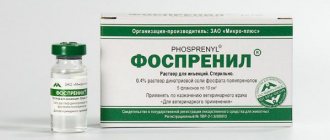5572Administration
A general blood test in cats is a fairly informative research method that can tell a lot about the health of the animal. Its results allow us to determine the cause of certain symptoms that appear in the pet. In addition, the analysis can detect a disease in a cat or dog that occurs latently, without signs.
This makes it possible to start treatment in a timely manner when the disease is at an early stage, and it is easy to overcome it. Often, along with this type of diagnosis, a general chemical blood test (biochemical) is prescribed, which allows you to get the clearest clinical picture about the condition of the cat’s body.
© shutterstock
How to properly prepare an animal for blood donation
- Before taking blood for analysis, the cat is not fed for 10-12 hours, and there must be free access to water.
- We limit the animal’s physical activity (refusal of games, etc.).
- Taking any medications is prohibited. If your cat regularly takes any medications as prescribed by your veterinarian, consult about stopping them.
- Before taking blood, therapeutic procedures, ultrasound, x-rays, and massage are unacceptable.
The procedure for taking blood for analysis
Blood is taken from the vein of the animal. To do this, the cat is placed on its side, and if the cat resists, it is secured in a special veterinary bag. Blood is taken from the front paw by shaving off a small area of fur. The injection site is treated with a disinfectant solution, a needle from a disposable syringe is inserted into the vein, blood in the amount of 2 ml is drawn into a test tube with heparin or sodium citrate.
What blood tests are performed in veterinary clinics?
In modern veterinary clinics, two laboratory blood tests are performed:
- General or clinical.
- Biochemical.
General blood test for a cat
A general blood test based on the number and condition of formed blood elements shows the health status of the cat’s body. When performing a general blood test, parasites such as dirofilaria (dirofilariasis), hemobartenella can be detected in a cat’s blood.
What indicators does the clinic’s veterinary specialist receive when conducting a general blood test:
- Hematocrit
- Hemoglobin.
- Average content and concentration of hemoglobin in an erythrocyte.
- Color indicator.
- ESR (erythrocyte sedimentation rate).
- Red blood cells.
- Leukocytes.
- Neutrophils.
- Lymphocytes.
- Eosinophils.
- Monocytes.
- Platelets.
- Basophils.
- Myelocytes.
Biochemical blood test for a cat
Biochemical blood tests allow veterinary specialists to identify subclinical (hidden) cat diseases. A biochemical blood test allows you to determine the functioning of the body’s enzymatic system and provide information about damage to a particular organ in a cat.
A biochemical blood test for a cat includes enzymatic, electrolyte, fat and substrate indicators.
Basic biochemical parameters:
- Glucose.
- Protein and albumin.
- Cholesterol.
- Bilirubin is direct and total.
- Alanine aminotransferase (ALT).
- Aspartate aminotransferase (AST).
- Lactate dehydrogenase.
- Gamma glutamyl transferase.
- Alkaline phosphatase.
- a –Amylase.
- Urea.
- Creatinine.
- Calcium.
- Magnesium.
- Creatine phosphokinase.
- Triglycerides.
- Phosphorus, inorganic.
- Electrolytes (potassium, calcium, sodium, iron, chlorine, phosphorus).
What symptoms indicate the disease?
The manifestation of signs such as bleeding from the gums or bruises on the skin indicate the development of pathology.
If a cat develops this pathological condition, the pet owner may notice the following signs:
- apathy;
- loss of appetite;
- lethargy;
- the appearance of pinpoint bruises on the skin and mucous membranes;
- the occurrence of hematomas for no apparent reason in the peritoneum and groin area;
- bleeding from the gums;
- blanching of the mucous membranes;
- frequent nosebleeds;
- impurities in fecal blood.
Return to contents
Indicators of blood tests obtained and their characteristics
Each indicator of a blood test shows the functioning of individual organs or entire systems, while the veterinarian takes into account not only each data separately, but also the relationship to each other.
Hematocrit is a conditional indicator showing the ratio of all formed elements of blood to its volume, i.e. determines the thickness of blood. Shows how much blood can carry oxygen.
Hemoglobin is a protein contained in red blood cells that ensures the movement of oxygen and carbon dioxide throughout the animal’s body.
The average concentration of hemoglobin in an erythrocyte shows in percentage terms how much erythrocytes are saturated with hemoglobin.
The color (color) blood index shows how much hemoglobin is contained in red blood cells in relation to the normal value.
ESR is an indicator that determines the presence of an inflammatory process in the body.
Erythrocytes are red blood cells that take part in tissue gas exchange and maintaining acid-base balance. It’s bad when test results go beyond the norm, not only in the direction of decrease, but also of increase.
Leukocytes (white blood cells) - indicate the state of the animal’s immune system. Leukocytes include lymphocytes, neutrophils, monocytes, basophils and eosinophils. For a veterinarian, the relationship between these cells is of diagnostic importance.
- Neutrophils are responsible for destroying bacteria in the blood.
- lymphocytes - speak of a general indicator of immunity.
- monocytes - perform the function of destroying foreign substances in the blood,
- caught in the blood.
- eosinophils - perform the function of fighting allergens.
- basophils - together with other leukocytes, help the body recognize and identify foreign particles that have entered the blood.
Platelets are blood cells responsible for blood clotting. In addition to this function, they are responsible for the integrity of blood vessels. Both high and low levels of them are dangerous for the body.
Myelocytes are located in the bone marrow and normally should not be in the blood.
Approximate forecasts depending on the blood picture
Scientists, and then practicing veterinarians, have learned to predict the outcome of the disease using the leukoformula. We will try to convey this information, maybe it will be useful to someone.
- A moderate increase in neutrophils (NE) with a slight shift in the presence of eosinophils (EOS) in smears indicates a simple infection. A gradual improvement in the picture indicates a speedy recovery.
- An increase in the total white blood cell (WBC) count with a mean shift with a decrease in EOS and lymphocytes (LYM) with further progression indicates infection.
- A significant increase in WBC with a strong shift to the left against the background of a decrease in LYM and EOS (up to their disappearance) makes it possible to judge a very serious condition, but there are still chances to get out. But if too many young cells appear (there are much more of them than rod cells), then the picture is disappointing.
- A constant decrease in WBC with a shift to the left, absence of EOS and a significant decrease in the number of LYM - death is guaranteed. At the same time, a progressive decrease in EOS against the background of an increasing WBC indicates an increase in infection, and the same decrease against the background of a fall in WBC indicates that the microbes have overcome the body’s resistance.
- The appearance of EOS and a decrease in NE in situations where the former were absent and the latter were too much – recovery is guaranteed.
- A sharp drop in LYM with existing clinical signs of infection is an unfavorable sign.
- A sharp decrease in LYM with increased NE indicates the spread of inflammation. The prognosis is poor when the WBC falls amid a strong shift to the left.
- An increase in LYM, which is followed by an increase in NE and an increase in EOS against the background of a gradual restoration of the amount of NE, indicates both an improvement in the general condition and a rapid recovery.
Thank you for subscribing, check your inbox: you should receive an email asking you to confirm your subscription
Blood chemistry
Glucose is an informative indicator indicating the functioning of a complex enzymatic system in the body, including individual organs (liver, pancreas, kidneys). Glucose metabolism in the body involves 8 different hormones and 4 complex enzymatic processes. A disorder is considered to be either high or low blood sugar levels in a cat.
Total protein in the blood reflects the correctness of amino acid metabolism in the body. Shows the total amount of all protein fractions - globulins and albumins. Proteins in an animal’s body take part in almost all life processes of the body. For specialists, both their increased and decreased amounts are important.
Albumin is the most basic blood protein produced by the liver. Albumin in a cat’s body performs a large number of functions (transporting nutrients, maintaining reserve reserves of amino acids for the body, maintaining osmotic blood pressure, etc.).
Cholesterol is a structural component that ensures the strength of cellular structures and takes part in the synthesis of many vital hormones. Veterinary experts judge lipid metabolism in a cat’s body based on cholesterol levels.
Bilirubin is a bile pigment found in the body in two forms - direct and indirect. Indirect bilirubin is formed in the blood as a result of the breakdown of red blood cells, and bound (direct) bilirubin is converted from indirect bilirubin in the liver. Bilirubin shows the functioning of the hepabiliary system (biliary and hepatic). Refers to “color” indicators i.e. when its content in the body is increased, the tissues turn yellow (jaundice).
Alanine aminotransferase (ALT, ALaT) and aspartate aminotransferase (AST, ACaT) are enzymes produced by liver cells, heart cells, red blood cells and skeletal muscles. It is an indicator of the functions of these organs or departments.
Lactate dehydrogenase (LDH) is an enzyme involved in the final step in the breakdown of glucose. Veterinary LDH specialists monitor the functioning of the cardiac and hepatic systems, and also judge the risks of tumor formation.
ɤ-glutamyltransferase (Gamma-GT) – in combination with other liver enzymes, provides insight into the functioning of the hepabilary system, pancreas and thyroid glands.
Alkaline phosphatase is determined to monitor liver function.
ɑ-Amylase – produced by the pancreas and parotid salivary gland. Their work is judged by its level, but always in conjunction with other indicators.
Urea is the result of protein processing, which is excreted by the kidneys. Some remains circulating in the blood. Using this indicator, you can check your kidney function.
Creatinine is a muscle byproduct excreted from the body by the renal system. The level fluctuates depending on the condition of the urinary excretory system.
Potassium, calcium, phosphorus and magnesium are always assessed in complex and in relation to each other.
Calcium is involved in the conduction of nerve impulses, especially through the heart muscle. By its level, you can determine problems in the functioning of the heart, muscle contractility and blood clotting.
Creatine phosphokinase is an enzyme that is found in large quantities in the skeletal muscle group. By its presence in the blood, one can judge the work of the heart muscle, as well as internal muscle injuries.
Triglycerides in the blood characterize the functioning of the cardiovascular system, as well as energy metabolism. Usually analyzed in conjunction with cholesterol levels.
Electrolytes are responsible for membrane electrical properties. Thanks to the electrical potential difference, cells pick up and execute commands from the brain. In pathologies, cells are literally “thrown out” from the nerve impulse conduction system.
What it is
Leukopenia is a process in which there is a decrease in leukocytes in the blood to a critical level.
Development mechanism
The virus multiplies at high speed. All healthy cellular structures are destroyed. The pathogen spreads throughout the body along with the blood, all organs and systems become infected.
The development of anemia contributes to the suppression of the protective barrier against viral and infectious pathogens. In fact, a double infection occurs, which is especially difficult for kittens to tolerate.
In most cases, the pathology ends in death for them.
Contagiousness
For humans, leukopenia is not dangerous and not contagious. The disease poses a particular threat to cats and kittens, as well as the entire feline family.
What amazes
The pathological process may involve the brain and other vital anatomical structures.
The heart muscle, bronchi, lungs, and gastrointestinal tract are most affected.
Disease outbreaks by season
The peak incidence occurs in the spring-summer period and is observed in young individuals. However, it is worth noting that the pathology often occurs in cats over 8 years of age.
Risk group
Among the most dangerous factors that can provoke the disease are:
- parvovirus enteritis;
- immunodeficiency virus;
- peritonitis of infectious origin.
The pathogen penetrates into leukocytes, causing the protective cells to die.
Other reasons causing the pathological condition:
- bacterial infections (from abscess to sepsis);
- bone marrow diseases: radiation, severe injuries, poisoning;
- inflammatory processes (when entering the chronic stage, the content of leukocytes in the blood decreases);
- pancreatitis: against the background of damage to the pancreas, the concentration of leukocytes begins to rapidly decrease, which after a certain period of time can lead to the development of leukopenia;
- stress: prolonged emotional arousal contributes to the disruption of many functions of the cat’s body, including bone marrow dysfunction.
Long-term use of certain medications suppresses the production of white blood cells. In such a situation, the disease is reversible and treatable.
Norms of blood tests in cats
- General (clinical) blood test
- Blood chemistry
| The name of indicators | Units | Norm |
| Ø hematocrit | % (l/l) | 26-48 (0,26-0,48) |
| Ø hemoglobin | g/l | 80-150 |
| Ø average hemoglobin concentration in an erythrocyte | % | 31-36 |
| Ø average amount of hemoglobin in a red blood cell | pg | 14-19 |
| Ø color indicator; | 0,65-0,9 | |
| Ø ESR | mm/hour | 0-13 |
| Ø red blood cells | million/µl | 5-10 |
| Ø leukocytes | thousand/µl | 5,5-18,5 |
| Ø segmented neutrophils | % | 35-75 |
| Ø band neutrophils | % | 0-3 |
| Ø lymphocytes | % | 25-55 |
| Ø monocytes | % | 1-4 |
| Ø eosinophils | % | 0-4 |
| Ø platelets | million/l | 300-630 |
| Ø basophils | % | — |
| Ø myelocytes | % | — |
Norms of blood tests in cats
General (clinical) blood test
Blood chemistry
| The name of indicators | Units | Norm |
| Ø glucose | mmol/l | 3,2-6,4 |
| Ø protein | g/l | 54-77 |
| Ø albumin | g/l | 23-37 |
| Ø cholesterol | mmol/l | 1,3-3,7 |
| Ø direct bilirubin | µmol/l | 0-5,5 |
| Ø total bilirubin | µmol/l | 3-12 |
| Ø alanine aminotransferase (ALT) | U/l | 17 (19) -79 |
| Ø aspartate aminotransferase (AST) | U/l | 9-29 |
| Ø lactate dehydrogenase | U/l | 55-155 |
| Ø ɤ-glutamyltransferase | U/l | 5-50 |
| Ø alkaline phosphatase | U/l | 39-55 |
| Ø ɑ-Amylase | U/l | 780-1720 |
| Ø urea | mmol/l | 2-8 |
| Ø creatinine | mmol/l | 70-165 |
| Ø calcium | mmol/l | 2-2,7 |
| Ø magnesium | mmol/l | 0,72-1,2 |
| Ø creatine phosphokinase | U/l | 150-798 |
| Ø triglycerides | mmol/l | 0,38-1,1 |
| Ø inorganic phosphorus | mmol/l | 0,7-1,8 |
| Ø Electrolytes | ||
| Ø potassium (K+) | mmol/l | 3,8-5,4 |
| Ø calcium | mmol/l | 2-2,7 |
| Ø sodium (Na+) | mmol/l | 143-165 |
| Ø iron | mmol/l | 20-30 |
| Ø chlorine | mmol/l | 107-123 |
| Ø phosphorus | mmol/l | 1,1-2,3 |
Leukocytes: norm and pathology
Next, we will consider the indicators of the leukocyte formula with the norm and deviations.
Leukocytes – white blood cells; the main role is to protect the body from pathogenic agents by absorbing and destroying them. The following types are distinguished: neutrophils, lymphocytes, basophils, monocytes, eosinophils.
- Norm: 5.5-18.5*103/l.
- Above normal. The increase can be physiological and reactive. Physiological occurs after eating, stress, pain, during pregnancy. As a rule, the physiological increase in the number of leukocytes is short-term. A true increase occurs during infections, inflammation, and young forms of cells predominate.
- Below normal: radiation exposure, infectious process, shock, long-term use of certain medications.
Neutrophils are live creatures that strive to destroy microbes, foreign particles and destructive cells in the body. In addition, they contain antibodies that neutralize microbes and foreign proteins.
- Normal: 0-3% band-nuclear and 35-75% segmented from the total number of leukocytes.
- Above normal: sepsis, any infection, oncology, leukemia, poisoning, long-term administration of corticosteroids and antihistamines.
- Below normal: impaired immune response, bone marrow tumors, long-term use of certain antimicrobial and other medications.
An increase in the number of young (rod) cells, the so-called shift to the left, indicates the severity of the process and weak reactivity (resistance) of the organism as a whole.
Eosinophils are another destroyer and neutralizer of foreign protein and toxins.
- Normal: 0-4% of the total number of leukocytes.
- Above normal: parasitic disease, allergies and skin diseases.
- Below normal: stress, old age, acute infection.
Basophils - synthesize heparin and histamine, both of these substances accelerate the process of resorption and healing of the inflammation.
- Normal: not detected.
- Above normal: allergies, inflammation in the intestines, administration of hormones, leukemia.
Lymphocytes produce antibodies, taking a direct part in the formation of immunity against infections; they also reject foreign protein after transplantation.
- Normal: 20-25% of the total number of leukocytes.
- Above normal: viruses, toxoplasmosis, lymphocytic leukemia.
- Below normal: immunodeficiency, long-term use of corticosteroids, liver and kidney diseases.
Blood tests in cats (transcript)
All deviations in indicators are considered in complex and in relation to one data to another within the same results from the study of one blood sample. Only an experienced veterinarian should interpret blood tests (results).
General (clinical) blood test
| The name of indicators | Promotion | Decline |
| 1. Hematocrit |
|
|
| 2. Hemoglobin |
|
|
| 3. ESR |
|
|
| 4. Red blood cells |
|
|
| 5. Leukocytes |
|
|
| 6. Segmented neutrophils (mature) |
|
|
| 7. Band neutrophils (immature) |
| |
| 8. Lymphocytes |
|
|
| 9. Monocytes |
|
|
| 10. Eosinophils |
| |
| 11. Platelets |
|
- incoagulability of blood. |
| 12. Basophils | hemoblastoses | Normally absent |
| 13. Myelocytes |
| Normally none. |
Blood chemistry
| The name of indicators | Promotion | Decline |
| 1. Glucose |
|
|
| 2. Protein |
|
|
| 3. Albumin |
|
|
| 4. Cholesterol |
|
|
| 5. Direct bilirubin |
| |
| 6. Total bilirubin |
|
|
| 7. Alanine amino-transferase (ALT, ALaT) |
| |
| 8. Aspartate aminotransferase (AST, ASat) |
|
|
| 9. Lactate dehydrogenase |
| |
| 10. ɤ-glutamyl transferase |
| |
| 11. Alkaline phosphatase |
|
|
| 12. ɑ-Amylase |
|
|
| 13. Urea |
|
|
| 14. Creatinine |
|
|
| 15. Calcium |
|
|
| 16. Magnesium |
|
|
| 17. Creatine phosphokinase |
| |
| 18. Triglycerides |
|
|
| 19. Inorganic phosphorus |
|
|
| 20. Electrolytes | ||
| · potassium |
|
|
| · sodium |
|
|
| · iron |
|
|
| · chlorine |
|
|
| · phosphorus |
|
|










